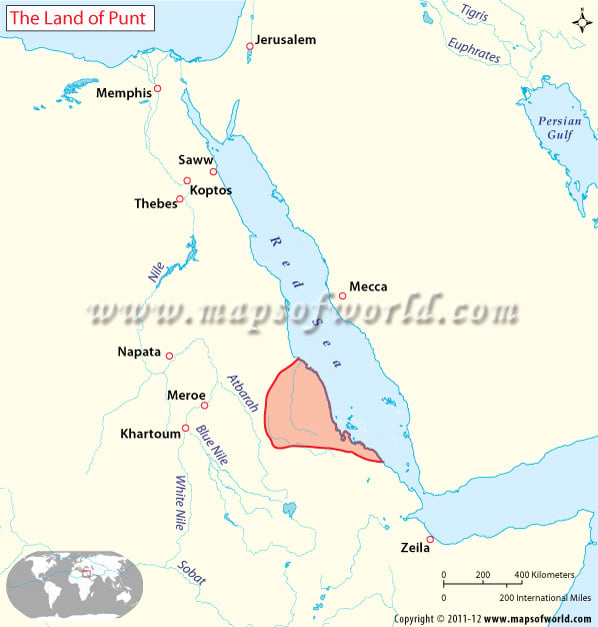While most modern civilizations have been fascinated by ancient Egypt, the ancient Egyptians themselves were enchanted by the fantastic Land of Punt. Not much is known about the rulers, the civilization, and even the location of this mythical land, except perhaps that it was rich in gold and ivory, resins, ebony, precious wood, and spices.
The people of Punt were active traders and frequently exchanged commodities with Egypt. The people probably had a darkish complexion and long, dark hair. Dwarfs and pygmies from Punt were sold into Egypt as slaves, and the skins of wild animals including cheetahs and giraffes were exported by the people of Punt.
Locating Punt
The precise location of the Land of Punt is still a mystery. Scholars broadly agree that Punt was plotted to the east of Egypt, possibly to the southeast. It is likely that the coastal regions of the Horn of Africa including Somalia, Eritrea, and Djibouti formed the erstwhile Land of Punt. Puntland, a region to the north of Somalia, derives its name from the mythical Land of Punt. Another school of historians and scholars, however, believe that the Land of Punt existed in the Arabian Peninsula and also cite references in support of such a view. This view seems untenable since products imported from Punt by the Egyptians, such as gold, ivory, resins, and spices, were found in Africa.
Egyptian Records
Most of our knowledge of the Land of Punt comes from the meticulous records maintained by Egyptians. The Egyptians undertook frequent expeditions to Punt and most of these were trade missions. The earliest Egyptian records of their expeditions to Punt date back to the Fifth Dynasty. The Egyptians seem to have imported from Punt frankincense and myrrh in addition to gold, ivory, and slaves. King Pepi II seems to have acquired a dwarf slave from Punt. Queen Hatshepsut (reign: 1503 BC to 1480 BC) left a record on the walls of the temple at Deir el-Bahri of all the wonderful items her ships brought back from Punt. Later kings including Thutmose III, Amenhotep III, and Ramses III were also known to trade with Punt
Ta Netjer – Land of the Gods
The Egyptians called the Land of Punt Ta Natjer. Literally translated, this means the Land of the Gods. Since Ra, the sun god, held a very important place in the Egyptian pantheon, historians believe that Punt was referred to as the Abode of the Gods because of its location to the east of Egypt, from where the sun might seem to rise. The name could also refer to the superior wood imported from Punt, which went into the building of Egyptian temples and to the frankincense and myrrh and other aromatic resins brought from Punt that were used extensively in religious rituals of the ancient Egyptians.
The mystery surrounding the civilization of Punt does not let us ascertain with any amount of accuracy the dates of its existence. Going by Egyptian trading records, though, historians believe that the civilization prospered approximately between 2450 BC and 1155 BC.

 Classical Greece Map
Classical Greece Map